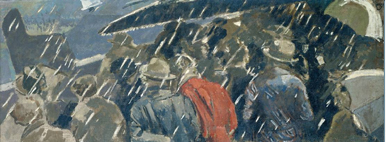Today is the first Sunday of the air show season, with displays taking place at Abingdon in Oxfordshire, Breighton in North Yorkshire and at the Imperial War Museum at Duxford, where the Jubilee Air Show will feature a number of stunts and fly-pasts involving vintage aeroplanes. This week’s aeronautically appropriate picture is Walter Richard Sickert’s muted homage to Amelia Earhart, the first woman to emulate Charles Lindbergh’s feat of flying solo across the Atlantic. Entitled Miss Earhart’s Arrival, it was painted in 1932, almost immediately after the successful conclusion of her pioneering flight, and can be seen at Tate Britain.
The picture is among other things a wry comment on the English weather’s dislikable habit of dampening festive spirits. Huddled against the cold and drenched by heavy rain, a stoical crowd of onlookers all but blocks from view the object of their adulation. On close inspection of the picture, Miss Earhart’s profile is visible – wearing a leather flying cap, her face is to be found between the hat of the man in the blue overcoat and the umbrella raised aloft in the upper-right corner – but only just. She is being shepherded away from under the wing of an aircraft, doubtless in the direction of some more official reception party, and has almost disappeared from view. The celebrated aviatrix seems both distant and a little distorted, as in an unflattering snapshot. The painter has reduced her to something like a caricature, or a shrunken head. He may have wanted to convey the way in which, under the glare of publicity, people often become oddly unlike themselves.
Having already flown across the Atlantic once, as a passenger, Amelia Earhart had set out on her solo flight from Harbour Grace, Newfoundland, on 20 May 1932. Her intended destination had been...


